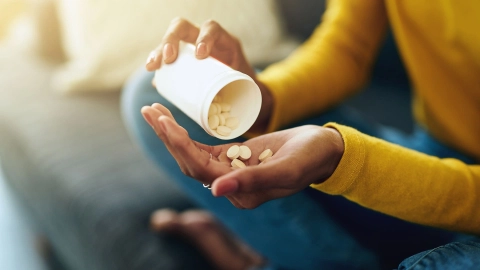Healthy living Legal highs – designer drugs that are actually illegal
Legal highs or new psychoactive substances are designer drugs that usually mimic the effects of well-known illegal drugs. Read on to find out about the health risks associated with legal highs and how the sale of these substances has been outlawed under the New Psychoactive Substances Act.
At a glance
- Legal highs (or new psychoactive substances) are designer drugs that often only differ slightly from drugs that have been around for much longer.
- Due to a legal loophole, their sale and consumption was not subject to prosecution – until an explicit ban came into force in 2016. Which means that these “legal” highs are now in fact illegal.
- Legal highs have a wide range of effects and side effects and are not well researched, which makes them risky to consume.
- They can also have long-term effects on the body and mind, such as organ damage and anxiety.
- Despite the risks to health, legal highs are often declared as incense blends or bath salts in an attempt to make them seem harmless.
Note: The information in this article cannot and should not replace a medical consultation and must not be used for self-diagnosis or treatment.

What are legal highs?
Legal highs or new psychoactive substances (NPS) are synthetically manufactured designer drugs that usually mimic the effects of well-known controlled substances.
In terms of their chemical composition, NPS are modified in comparison with controlled substances (e.g., crystal meth) so that they do not appear on the list of banned substances under the Federal Narcotics Act (Betäubungsmittelgesetz, BtMG). However, their consumption is neither legal nor harmless. Most new psychoactive substances present the particular risk that their precise effects and long-term consequences are not well understood.
NPS are largely sold on the Internet, where they are misleadingly labeled as “bath salts”, “incense blends” or “plant food”. While the ingredients they claim to contain (e.g., herbs) may actually be found in these drugs, they serve only as a means of disguising and carrying the psychoactive substance.
Why are these drugs called “legal highs”?
Prior to the end of 2016, legislators only had the power to ban new drugs under the Federal Narcotics Act (BtMG) or Pharmaceutical Products Act (Arzneimittelgesetz, AMG). This meant that a separate process had to be initiated to ban each individual new designer drug that appeared on the market, which was very time-consuming. While not explicitly legalized, the manufacturing, sale, possession and consumption of these substances was not subject to prosecution until each ban became effective. As a result, these new psychoactive substances (NPS) also became known as “legal highs”.
Moreover, banning a new drug didn’t solve the problem – as soon as a new substance was outlawed, the manufacturer could easily alter its chemical structure so that it was no longer covered by the ban that had just come into force. This enabled a steady rise in the sale of new psychoactive substances.
To take effective action against this development, legislators had to introduce a more efficient way to ban the relevant substances. This resulted in the New Psychoactive Substances Act (NpSG), which came into effect in 2016.
What is the New Psychoactive Substances Act (NpSG)?
The New Psychoactive Substances Act (NpSG) is a German law for effectively combating new drugs – it enables the banning of entire substance groups rather than individual designer drugs only. These groups currently include:
- compounds derived from 2-phenethylamine
- synthetic cannabinoids (“fake weed”)
- benzodiazepines
- compounds derived from N-(2-aminocyclohexyl)amide
- tryptamine-derived compounds
- arylcyclohexylamine-derived compounds
- benzimidazole-derived Compounds
In the future, additional substance groups can be included under the law or existing substance groups can be modified.
How are legal highs supplied and sold?
Legal highs, i.e. new psychoactive substances (NPS) are mostly supplied and sold on the Internet. It is much rarer for consumers to have personal contact with dealers. This means that manufacturers can, in principle, sell designer drugs to people with very little prior knowledge and can sell to a global market.
NPS are often disguised using deceptive product names, colorful packaging and misleading descriptions that fail to mention which psychoactive substances they contain. This serves to make legal highs appear harmless, and thus more attractive – especially to younger people.
Despite all of the mechanisms of deception and disguise used in connection with NPS, there are certain typical formats in which these drugs tend to be sold. In general, those sold as “incense blends” or “air fresheners” are substances that are smoked or consumed in the form of tea, while “bath salts” tend to be snorted and “plant food” tablets are swallowed.
How many people consume legal highs?
In Germany, around 3 percent of adults have had contact with legal highs (new psychoactive substances or NPS) at least once. Almost 1 percent of German adults consume this type of drug on a regular basis. Use of NPS is currently not very prevalent among adolescents and young adults in Germany.
The most frequently consumed are synthetic cannabinoids, followed by synthetic cathinones.
One problem that arises when trying to estimate how many people consume NPS is that many of these drugs cannot be detected using conventional rapid screening tests. In most cases, complicated blood tests that cannot be carried out by regular labs are required for detection.
Recorded deaths due to legal highs are rare but on the rise. According to the statistics, 98 people died as a result of consuming NPS in 2016, which represents an increase of more than 50 percent on the year before.
What are the effects and side effects of legal highs?
Legal highs, also known as new psychoactive substances, can be classified according to their various substance classes or based on the ways in which they work.
The groups known as stimulants, hallucinogens and cannabinoids, are particularly widespread.
Stimulants
As their name suggests, stimulants have a stimulating, invigorating effect on the brain and body. Well-established illegal stimulants include cocaine, speed and crystal meth. Stimulants in the NPS category include synthetic cathinones. Their effects are similar to those of amphetamines, such as a speed. These drugs boost concentration, alertness and readiness to react. They also give people a sense of self-confidence or even euphoria. They also lower inhibitions.
Due to their stimulating effects, heart palpitations, excessive sweating and digestive disturbances are some of the immediate side effects of these drugs. Taking them in excess can lead to aggressive behavior, impaired consciousness and psychotic experiences, such as delusions.
Hallucinogens
Hallucinogens are also known as psychedelics. The best known illegal hallucinogen is probably LSD (lysergic acid diethylamide). Many drugs in the NPS category also have hallucinogenic effects. Hallucinogens affect perception, alter sensory input, stimulate the imagination and can produce hallucinations.
The direct side effects of hallucinogens include heart palpitations, light sensitivity and mood swings. However, other possible effects include delusions and anxiety attacks (“bad trips”) and even drug-induced psychosis, where the individual loses touch with reality.
Cannabinoids
Synthetically manufactured cannabinoids such as the designer drug known as “spice” bind to the same receptors in the body as THC – the main constituent of cannabis. These receptors are known as endocannabinoid receptors. In this way, they mimic THC but, in some cases, the effects are much stronger and last much longer. Their potential effects range from deep relaxation and an unfounded feeling of exhilaration to an irresistible need for action and intense hallucinations.
The spectrum of possible side effects is large and includes heart palpitations, circulatory problems, shortness of breath, dry mouth, nausea, seizures and panic attacks. Cannabinoids are among the least safe of the new psychoactive substances and it can be particularly easy to get their dosage wrong.
For more information about these and other sub-groups within the NPS category, see www.drugcom.de, a website operated by the Federal Center for Health Education (“Bundeszentrale für gesundheitliche Aufklärung”).
The exception – cannabis for medicinal purposes
Unlike cannabinoids, cannabis is a naturally occurring substance. It is extracted from the hemp plant and has long been used by humans as an intoxicant. Since March 2017, doctors in Germany have been legally permitted to prescribe medication containing cannabis for patients with serious illnesses, e.g., to relieve pain. However, this option can only be considered if other treatment methods have already proven unsuccessful.
Important: The therapeutic benefits of medicinal cannabis remain unclear and further research is required. Medicinal cannabis can also produce significant side effects. Therefore, as with all types of medication, it should only be taken after carefully weighing up the benefits and drawbacks.
What long-term damage to health can be caused by legal highs?
Legal highs, i.e. new psychoactive substances (NPS) are often based on research chemicals. These are products that were originally developed as part of pharmacological research. These synthetically manufactured substances often have a much more powerful effect than the naturally occurring substances on which they are based – as highlighted by the example of cannabis and cannabinoids. As a result, consuming NPS is also associated with a greater risk of overdosing and serious health-related consequences.
In addition, legal highs almost always come with misleading packaging and product descriptions and often originate in unregulated labs in Asian countries. This means that people using legal highs don’t usually know exactly what they are consuming.
In contrast to medication, the effects of most of these substances have never been tested using controlled trials with human subjects. As a result, the potential side effects and complications associated with their consumption are wide-ranging and unpredictable.
Possible physical complications include:
- weakening of the immune system
- organ damage
- severe weight loss in some cases
- disruption of the menstrual cycle
- interference with the effect of the contraceptive pill
- with nasal drug consumption: damage to the nasal septum, loss of the sense of smell and/or taste
- with consumption during pregnancy: an increased risk of fetal deformities, premature delivery and stillbirth
Possible psychological and social consequences include:
- anxiety, panic attacks, depression, hallucinations, paranoia, psychosis
- suicidal thoughts
- impaired concentration and memory
- personality changes, such as emotional coldness
- sleep disturbances and disorders
- psychological symptoms even when sober
- legal and financial problems associated with purchasing drugs
- problems with social contact and a tendency to self-isolate
Important: As with other drugs, the consumption of NPS can lead users to develop tolerance, in what is known as the habituation effect. They need to continuously increase their dose to achieve the desired effects. And, if the dose is not increased, they may experience the effects of withdrawal, such as shaking and feelings of anxiety.
Where is more information available?
There are many reasons why young people may fall behind with their schoolwork, become aggressive or show other concerning behaviors. If parents suspect that they are consuming legal highs, they shouldn’t be afraid to seek help on their behalf.
The German Center for Addiction Issues (Deutsche Hauptstelle für Suchtfragen e.V. - DHS) provides parents, teachers and drug users who are seeking help with comprehensive information about preventing and managing addiction. The website also offers a directory of addiction supports, listing local advice and support centers around the country.
In-depth information aimed in particular at adolescents and young adults is provided on drugcom.de, a website operated by the Federal Center for Health Education (Bundeszentrale für gesundheitliche Aufklärung). The website provides information about the effects and risks associated with illegal drugs.
The video “What are legal highs?” provides a clear overview of NPS, with a particular focus on synthetic cannabinoids.
You will find information about the New Psychoactive Substances Act (NpSG) on the website of the Federal Ministry of Health (Bundesministerium für Gesundheit).
- Bundesministerium für Gesundheit. Das Neue-psychoaktive-Stoffe-Gesetz (NpSG). Aufgerufen am 16.12.2021.
- Cochrane Kompakt. Cannabisprodukte für Erwachsene mit chronischen neuropathischen Schmerzen. Aufgerufen am 16.12.2021.
- Deutsche Apotheker Zeitung (DAZ). Illegal Highs. Aufgerufen am 16.12.2021.
- Deutschen Hauptstelle für Suchtfragen e. V. Neue psychoaktive Substanzen – Basisinformationen. Aufgerufen am 16.12.2021.
- Die Drogenbeauftragte der Bundesregierung. Jahresbericht 2021. August 2021.
- Kassenärztliche Bundesvereinigung (KBV). Cannabis - was Ärzte bei der Verordnung wissen müssen. Aufgerufen am 16.12.2021.
- Strube A, Schaper A. Bonzai, Blei und Badesalz – Vergiftungen mit neuen und alten Drogen. Med Klin Intensivmed Notfmed 2019. 114:684–692.
Reviewed by the Professional Association for Addiction (Fachverband Sucht e.V.).
As at:





